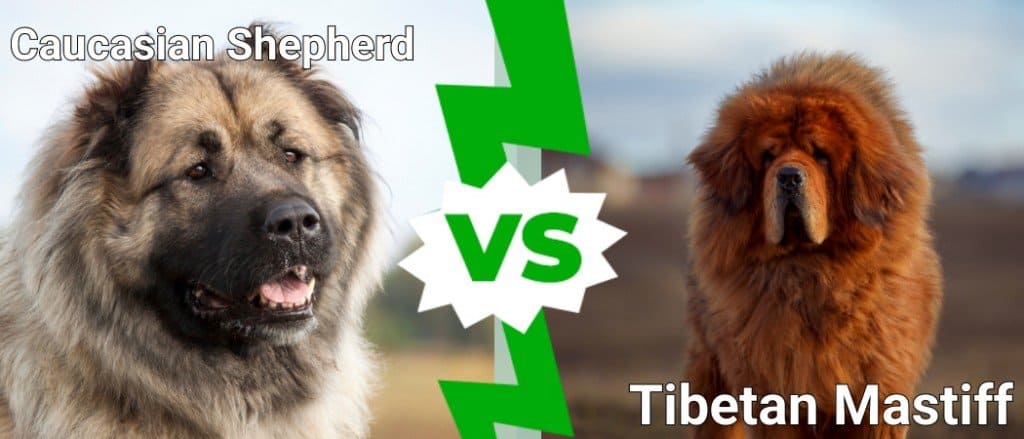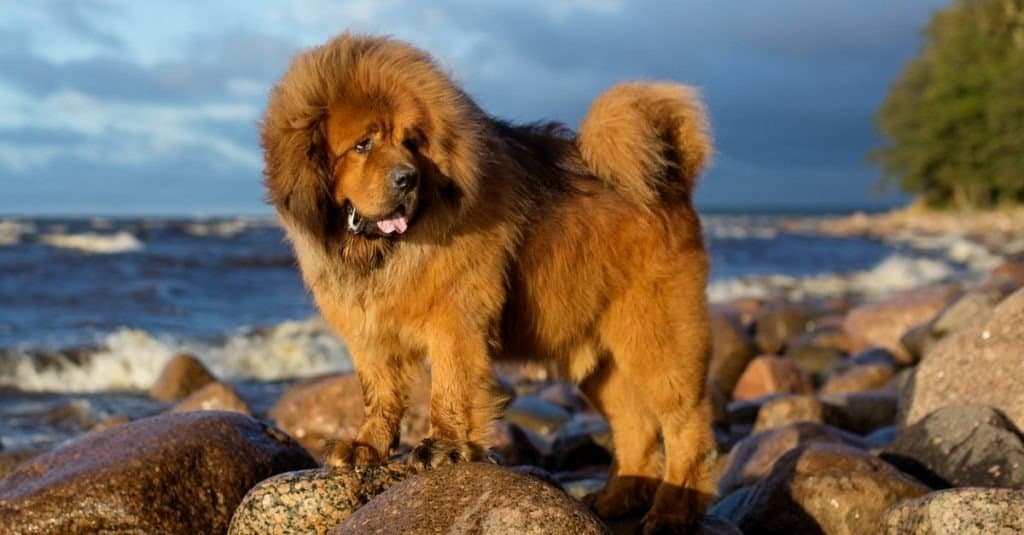The Caucasian Shepherd and Tibetan Mastiff are two different but popular domestic dog breeds. Despite their differences, however, a close Caucasian Shepherd vs. Tibetan Mastiff comparison shows that these two are more similar than one may think. Both are smart and loyal dogs that are great for providing protection when properly trained.
Knowing fact from fiction and which one is which is important, however, and some of the best ways to tell these two apart is by looking for some of the key differences, which we’ll explore further in this article. However, these two separate breeds also have many key differences, which we will be exploring further in this article. Keep reading to learn more about the differences between the Caucasian Shepherd and Tibetan Mastiff.
Comparing Caucasian Shepherd and Tibetan Mastiff

While the Caucasian Shepherd and the Tibetan Mastiff are similar in many aspects, there are a couple of noticeable differences to help you tell which is which.
| Caucasian Shepherd | Tibetan Mastiff | |
| Size | 23 to 30 inches tall 99 – 170 pounds | 24 inches tall or greater 70 – 150 pounds |
| Coat/Hair Type | Double coat with long, coarse topcoat and fine, soft undercoat | Double coat with a thick, coarse topcoat and a woolly undercoat |
| Colors | Gray, fawn, red, cream, tan, and solid white. Coats may be brindle or have two or more colors. | Black or blue, with or without tan marking; fawn, red, sable |
| Temperament | Intelligent, protective, stubborn | Intelligent, protective, gentle |
| Trainability | Very trainable | Very trainable |
| Life Expectancy | 10 – 12 years | 12 years |
| Energy Levels | Low energy | Low energy |
Caucasian Shepherd Vs. Tibetan Mastiff: 8 Key Differences

Tibetan Mastiffs have large, thick coats that make them look a lot bigger than they are!
©Kat_marinina/Shutterstock.com
While the Caucasian Shepherd and Tibetan Mastiff may look similar, they’re not the same. First, there’s no doubt that both breeds are rather large dogs. However, the Caucasian Shepherd is around 15 percent larger than the Tibetan Mastiff. The Caucasian Shepherd also has a distinct appearance, with lighter coat colors and a sharper, more angled head shape. As for trainability, both can be easily trained for experienced owners but may give first-time dog owners a hard time by pushing their boundaries.
Let’s take a closer look at these 8 key differences to see just how unique each breed is.
Caucasian Shepherd vs Tibetan Mastiff: Appearance
At a first glance, it’s easy to mistake these two big breeds. After all, in terms of coloration and markings, the Caucasian Shepherd and Tibetan Mastiff are similar. However, it takes only a second glance to realize just how difficult they can be in terms of appearance.
Caucasian shepherds have an appearance more similar to common dog breeds. They have narrow heads with a thicker body, as well as a thick coat. They can come in either light or dark patterns.
The Tibetan Mastiff, however, is a much more unusual breed! It has a similarly large, rounded body, but its head also appears larger due to the thick “mane” it often sports. Tibetan mastiffs are also known for having a more uniform coloration compared to Caucasian shepherds who may have many markings.
Caucasian Shepherd vs Tibetan Mastiff: Size
There’s no doubt that both the Tibetan Mastiff and Caucasian Shepherd are some of the biggest dogs around. However, when it comes to a comparison between these two breeds, the Caucasian Shepherd is larger.
But by how much?
At the shoulders, the Caucasian Shepherd can be as tall as 30 inches. Some of the smaller adults are only 26 inches. In comparison, the Tibetan Mastiff is only around 24 inches tall.
At 99 to 170 pounds, the Caucasian Shepherd also outweighs the Tibetan Mastiff, who only weighs a maximum of 150 pounds. This just goes to show that a lot of the mastiff’s size is the result of their large, fluffy coats!
This size difference is why the Caucasian Shepherd is considered a giant breed and the Tibetan Mastiff only a large breed.
Caucasian Shepherd vs Tibetan Mastiff: Grooming
Speaking of fluffy coats, it’s also important to consider grooming needs when considering the key differences of the Caucasian Shepherd vs Tibetan mastiff.
The Caucasian Shepherd requires grooming at least every two weeks – or else it’ll become so tangled and matted that you’ll need a professional groomer! Aside from regular brushing, you’ll also need to make sure to take the time every day or so to wipe down and dry this giant breed’s face and neck. This is because they’re prone to drooling.
The Tibetan Mastiff can go a little bit longer without a full grooming routine, requiring it at least every six weeks.
For both breeds, it’s recommended to brush them every day, especially at the turn of seasons. This helps remove shed hair and dandruff while also preventing mats and tangles. Despite having large amounts of fur, shaving is rarely ever recommended for breeds with a double coat.
Caucasian Shepherd vs Tibetan Mastiff: Temperament

Tibetan mastiffs are more laid-back than Caucasian shepherds.
©Olga Aniven/Shutterstock.com
Large livestock dogs, Caucasian Shepherds have a lot of traits you may be familiar with from other breeds commonly found working in rural areas. They’re dominant, alert, and powerful, but they’re also calm and attentive to those around them. These shepherds are also extremely loyal to their families and are known for being protective.
Tibetan Mastiffs possess many of these qualities, but they’re more sensitive to the humans around them. This means that they’re more likely to be affected by praise or scolding, despite their independence.
Caucasian Shepherd vs Tibetan Mastiff: Trainability
Because Caucasian shepherds can be independent and strong-willed, this makes them difficult to train. However, since their protectiveness can lead to aggression with strangers, proper training is a must for owning this breed.
Tibetan Mastiffs can be a bit easier to train, although they’re not recommended for first-time owners. They have a tendency of pushing boundaries and test how firm you are in your commands, which can lead to untrained pup if not handled correctly.
Caucasian Shepherd vs Tibetan Mastiff: Health
As large breeds, you will find many similar health risks between the Caucasian Shepherd and the Tibetan Mastiff. These health issues can include:
- Hip dysplasia
- Elbow dysplasia
- Hypothyroidism
- Eye disorders.
Caucasian Shepherd vs Tibetan Mastiff: Life Expectancy
While both of these breeds may differ widely in some regards, one area where worlds collide is their life expectancies. Two large, hardy breeds, whether you choose to bring a Caucasian Shepherd or Tibetan Mastiff into your home, you can expect to enjoy over a decade with either.
With an average maximum life expectancy, however, the Tibetan Mastiff does tend to live around two years longer than most Caucasian Shepherds.
Caucasian Shepherd vs Tibetan Mastiff: Energy
There’s a notorious rumor that Tibetan Mastiffs are lazy. However, you’ll be surprised to learn that these overgrown pups aren’t necessarily low energy – they just know what they want to do and when they want to do it. While you’ll catch them catching the occasional cat-nap, they do enjoy walks or other mild opportunities with their family.
Caucasian shepherds have a similar energy level, although they’re more likely to jump into action. This is due to their breeding as livestock guard animals, which makes them more likely to remain alert and reactive towards threats.
Conclusion

The Caucasian shepherd dog was originally bred as a working dog and used to guard livestock against predators.
©anetapics/Shutterstock.com
Both the Caucasian Shepherd and Tibetan Mastiff are low-energy, loyal, and intelligent dogs. They’re highly protective over their family, whether that’s humans or other pets, and they need moderate to high levels of grooming to combat their thick coats.
The Tibetan Mastiff tends to be a bit more laid back than the Caucasian Shepherd, however. They also have a larger lifespan, despite the fact that both breeds suffer from similar health issues. With proper training, either breed could be a good fit for experienced dog owners.
The photo featured at the top of this post is © Pleple2000, CC BY-SA 4.0, via Wikimedia Commons – License / Original
Ready to discover the top 10 cutest dog breeds in the entire world?
How about the fastest dogs, the largest dogs and those that are -- quite frankly -- just the kindest dogs on the planet? Each day, AZ Animals sends out lists just like this to our thousands of email subscribers. And the best part? It's FREE. Join today by entering your email below.
Thank you for reading! Have some feedback for us? Contact the AZ Animals editorial team.






